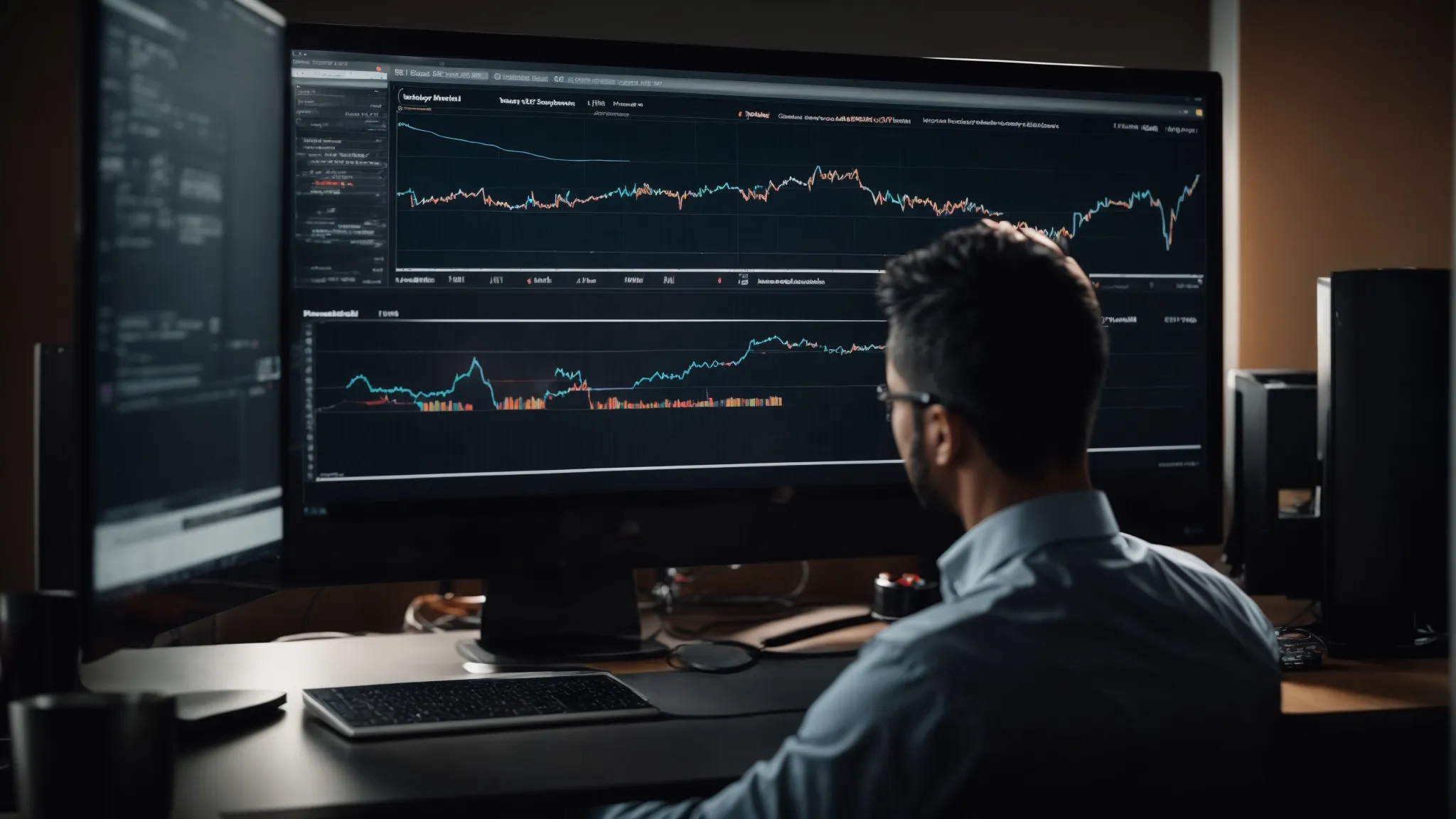Achieving Performance in Marketing
Maximizing Results: Strategies for Achieving Performance in Marketing In the dynamic realm of marketing, achieving peak performance is likened to mastering a complex symphony, each movement coordinated […]
Maximizing Results: Strategies for Achieving Performance in Marketing
In the dynamic realm of marketing, achieving peak performance is likened to mastering a complex symphony, each movement coordinated and every note resonating with the audience.
Performance marketing campaigns meld art with analytics, where strategic objectives align seamlessly with execution, paving the way for exponential growth and sustainable success.
Mutually reinforcing strategies such as audience segmentation, multi-channel outreach, and data-driven insights create a tapestry of techniques that enrich the digital marketing landscape.
Companies that skillfully harness these approaches witness their brands thrive in an ever-evolving marketplace.
Keep reading to discover how setting clear goals and embracing advanced technologies can transform your marketing endeavors into measurable triumphs.
Key Takeaways
- Establishing SMART Objectives Is Essential to Transform Vague Aspirations Into Actionable and Measurable Marketing Goals
- Utilizing Advanced Analytics Tools Like LinkGraph’s SearchAtlas SEO Software Enables Marketers to Optimize Campaign Performance
- A Robust Content Strategy, Optimized for Search Engines, Is Critical for Enhancing a Brand’s Online Visibility and User Engagement
- Maintaining Brand Consistency Across Various Platforms Strengthens Brand Identity and Accelerates Customer Loyalty
- Fostering a Continuous Improvement Culture Within Marketing Teams Is Crucial for Adapting to Industry Trends and Driving Performance
Setting Clear Marketing Goals to Drive Performance

In the intricate world of digital marketing, setting laser-focused objectives is the cornerstone for driving performance and achieving tangible outcomes.
Precision in goal-setting empowers companies to chart a clear path toward success, underscored by the establishment of SMART marketing objectives—those which are Specific, Measurable, Achievable, Relevant, and Time-bound.
This strategic approach is pivotal and serves as a funnel through which all subsequent efforts flow, be it identifying critical Key Performance Indicators (KPIs), aligning marketing aims with the overarching business strategy, or implementing robust benchmarks and tracking systems.
With the dynamic nature of digital landscapes, regular review and adjustment of marketing goals are imperative, ensuring that strategies remain agile and responsive to an ever-evolving market.
Establish SMART Marketing Objectives
In the pursuit of exceptional campaign performance, the formulation of SMART objectives serves as a guiding beacon for digital marketers. It is their meticulous attention to these criteria that transforms vague aspirations into actionable and trackable benchmarks, providing clarity to both the trajectory and the tactics of a marketing strategy.
Success in digital marketing is often a reflection of how well objectives are crafted and aligned with a brand’s unique digital footprint. Through the lens of SMART goals, marketers can distill complexities into precise, attainable targets that resonate with a brand’s mission, audience engagement, and market positioning, thus paving the way for measured success.
Identify Key Performance Indicators (KPIs)
For marketing professionals aiming to measure the pulse of their campaigns, selecting the appropriate Key Performance Indicators (KPIs) is a critical step. These indicators act as navigational beacons, guiding performance marketers through the sea of data to pinpoint the metrics that matter most—be it conversion rates, lead generation, or customer engagement levels.
LinkGraph’s Suite of Tools, including SearchAtlas, assists clients in establishing relevant KPIs tailored to their specific marketing objectives. The emphasis on precise metrics allows for the distillation of performance data into actionable insights, facilitating the optimization of marketing efforts and ensuring alignment with the desired outcomes of a campaign.
Align Marketing Goals With Business Strategy
Marketing goals gain substance when they’re woven into the fabric of a company’s broader business strategy. Such alignment ensures that every marketing campaign contributes to the ultimate vision of the organization, whether that’s market expansion, customer loyalty, or revenue growth.
Achieving synergy between marketing and overall business strategies requires a deep understanding of the organization’s values, target market, and long-term objectives. This strategic fusion fuels a company’s marketing efforts, directing attention to areas that offer the most significant impact:
- Identifying growth opportunities within the market that align with business expansion goals.
- Adjusting marketing initiatives to focus on driving customer retention and lifetime value, key components of sustainable business growth.
- Deploying marketing resources effectively to support new product launches or entry into new markets, in line with the company’s strategic roadmap.
Set Benchmarks and Tracking for Goals
Within the realm of performance marketing, setting benchmarks and putting in place effective tracking systems are indispensable steps for marketers aiming to ascertain the efficacy of their campaigns. Benchmarks act as performance yardsticks, allowing marketers to establish expectations based on industry standards or past campaign data, thereby injecting a dose of objectivity into the assessment of marketing initiatives.
Embracing sophisticated tracking protocols positions LinkGraph’s clients to gain comprehensive visibility into the nuances of campaign performance. Here’s where the value of performance indicators comes into sharp relief:
- Providing real-time data that illuminate the success trajectory of ongoing campaigns.
- Enabling swift identification of underperforming areas which require strategic re-calibration.
- Empowering marketers with insights to refine future marketing efforts for amplified results.
Regular Goal Review and Adjustment
In an industry where change is the only constant, the need for regular goal review and adjustment holds remarkable significance for performance marketers and brands alike. This dynamic process enables responsiveness to market shifts, customer behavior changes, and the influence of emerging technologies on marketing strategies.
LinkGraph’s suite underscores the importance of agility in goal adjustment, where marketers can harness the SearchAtlas SEO software‘s analytics to gauge campaign effectiveness and iterate on strategies accordingly. This cycle of evaluation and refinement is instrumental in maintaining campaign alignment with core business objectives and adapting to the fluid nature of digital landscapes:
- Employing data trends from regular performance reviews to inform strategic decision-making.
- Adjusting resource allocation and strategic focus based on updated analytics to optimize campaign efficacy.
- Calibrating marketing efforts to stay ahead of competitors and capture emerging opportunities in real time.
Integrating Data Analytics for Enhanced Decision Making

In today’s digital age, the ability to sift through the noise and extract meaningful insights from data has taken center stage in performance marketing.
Marketers are increasingly turning to advanced analytics tools to dissect performance metrics, uncovering layers of insights that drive strategic decisions.
As they pivot from raw data to refined strategy, professionals orchestrate A/B testing, apply data interpretation, and leverage real-time feedback to optimize and propel their marketing campaigns forward.
This commitment to data-driven approaches not only sharpens their strategic edge but also ensures their marketing maneuvers are continually adjusted to meet the evolving needs of their target audience.
Leverage Marketing Analytics Tools
Within the strategically charged domain of performance marketing, harnessing marketing analytics tools is not just prudent, it’s essential for success. LinkGraph’s state-of-the-art SearchAtlas SEO software provides marketers with a robust platform to meticulously analyze campaign data, facilitating the distillation of insights and empowering data-driven strategies that underpin marketing successes.
Utilizing tools like LinkGraph’s SearchAtlas software elevates a company’s capacity to scrutinize campaign performance minutely, ensuring the alignment of marketing tactics with predefined objectives. By doing so, these analytics tools enable businesses to efficiently allocate resources and tailor their strategies to enhance engagement and conversion, optimizing overall digital marketing endeavors.
Interpret Data to Inform Strategy
Data interpretation is not merely an exercise in number-crunching; it is an art that transforms statistics into strategic direction. With tools like LinkGraph’s SearchAtlas, marketers can sift through complex data sets to extract the pivotal information needed to tailor strategies that resonate with their target audiences.
The actionable insights gained from adept data interpretation guide companies in fine-tuning their performance marketing strategies. By applying these insights, LinkGraph helps businesses to not only meet the immediate needs of their audience but to anticipate and prepare for future market trends, ensuring sustained relevance and success.
Utilize a/B Testing for Optimization
In their quest for peak campaign performance, digital marketers frequently leverage A/B testing—a methodical process of comparing two variations of a digital asset to determine which one performs better. LinkGraph’s robust toolkit embodies this optimization technique, offering professionals the ability to test hypotheses, refine user experiences, and incrementally enhance the effectiveness of every component of their digital marketing strategy.
This commitment to empirical testing is a hallmark of intelligent marketing strategies, where decisions are driven by verifiable data rather than intuition. Through the use of SearchAtlas software, digital marketers at LinkGraph are able to ascertain the most impactful elements, from headline to landing page design, ensuring that each adjustment is contributing to an increase in conversion rates and overall campaign success.
Translate Insights Into Actionable Tasks
Translating insights into actionable tasks is a critical step in the optimization of performance marketing strategies. LinkGraph’s suite, through tools like the SearchAtlas SEO software, empowers marketers to convert complex data analyses into clear, attainable actions that can profoundly influence a campaign’s trajectory and success.
Adapting marketing strategies to incorporate these tasks ensures that every insight culled from data analytics paves the way for informed decisions and tangible improvements in marketing efforts. With this approach, LinkGraph effectively bridges the gap between data interpretation and practical execution, enhancing the efficacy of digital marketing frameworks.
Monitor Real-Time Results to Stay Agile
In the realm of performance marketing, the capacity to monitor campaign outcomes in real-time equates to retaining a competitive edge. The agile marketer employs LinkGraph’s analytical prowess to detect shifts in campaign performance instantaneously, facilitating the execution of modifications at the speed of market demands.
Using LinkGraph’s SearchAtlas SEO software, marketing professionals get live feedback that feeds directly into strategic adjustments, allowing campaigns to remain fluid and responsive. This real-time monitoring is crucial in the fast-paced digital marketing landscape, where staying agile means staying on top, and even a momentary lag can mean missed opportunities.
Mastering the Art of Audience Segmentation

In the pursuit of performance in marketing, audience segmentation emerges as a refined art form crucial to the success of any strategic endeavor.
By dissecting the broad spectrum of potential customers into manageable groups with shared characteristics, companies are poised to tailor their marketing strategies with laser precision.
This granular approach to understanding and categorizing the audience facilitates the creation of personalized campaigns, sharpens retargeting efforts, enriches content relevance for distinct groups, and endlessly refines marketing tactics.
Each segment reveals its own patterns and preferences, enabling marketers to orchestrate campaigns that not only connect to the heart of each audience but also drive meaningful engagement and results.
Define Your Target Market Precisely
Defining one’s target market with precision is a cardinal rule in the domain of performance marketing. It requires marketers to immerse themselves in comprehensive research, leveraging tools like LinkGraph’s SearchAtlas to dissect demographic, psychographic, and behavioral data, thus illuminating the contours of a defined audience segment keenly responsive to a company’s messaging.
The granularity of this process equips marketers to position their brand effectively, ensuring that messaging, product positioning, and marketing tactics are meticulously crafted to meet the nuanced needs and wants of their target customer. With a well-defined target market, businesses are better positioned to develop resonant marketing strategies that captivate the intended audience and drive meaningful engagement.
Develop Personalized Marketing Campaigns
Developing personalized marketing campaigns is a multi-faceted endeavor that centers on delivering tailored messages to engage each segment of the target audience. By leveraging the insights provided by the SearchAtlas SEO software from LinkGraph, marketing professionals craft campaigns that speak directly to the interests and behaviors of their buyer personas, elevating the relevance and thus the effectiveness of their marketing communications.
Personalization extends beyond mere customization of names or titles; it’s about creating an experience that resonates deeply with the audience, making each interaction meaningful. Utilizing the powerful analytics and content planning tools available through LinkGraph, marketers can fine-tune their strategies, ensuring that each message strikes the right chord with its intended recipient, fostering stronger connections and driving conversions.
Employ Retargeting Strategies for Engagement
Retargeting strategies stand as a testament to performance marketing’s capacity for nuanced engagement. Through such strategies executed with precision, LinkGraph’s suite of tools like SearchAtlas SEO software aids marketers in recapturing the attention of users who have previously interacted with a brand but have not converted, seamlessly reintegrating them into the marketing funnel.
The power of retargeting lies in its ability to serve tailored advertisements to individuals based on their prior online behavior, making it a strategic imperative for brands seeking deeper engagement. LinkGraph’s Advanced Data Analytics facilitate the development of retargeting campaigns that resonate on a personal level, reminding users of their initial interest and inviting them back to complete their customer journey.
Create Segment-Specific Content
Crafting segment-specific content goes beyond generalities and delves into the unique interests and concerns of each audience subdivision. With LinkGraph’s content planning tool and the expertise of seasoned marketers, companies can produce customized material that speaks to the heart of different audience segments; such as bespoke blog posts for tech enthusiasts or tailored newsletters for health-conscious individuals, ensuring heightened relevancy and engagement.
LinkGraph’s SEO content assistant emerges as an invaluable asset for marketers seeking to optimize their segment-specific content. It ensures each piece of content is not just tailored to the audience but also primed for search engine visibility, leveraging the intricate algorithms to meet both user intent and search engines’ criteria, thereby enhancing the reach and impact of the marketing strategy.
Use Segmentation Data to Refine Tactics
Segmentation data is the compass that guides marketing professionals in honing their tactics. Utilizing the precision of tools like LinkGraph’s SearchAtlas, marketers refine their approaches by aligning them more closely with the unique characteristics and preferences discerned from their segmentation analyses.
In turn, this strategic alignment ensures marketing endeavors are not cast into the void but are targeted with precision, fostering increased efficiency. With focused tactics derived from segmentation data, companies can capitalize on stronger, more resonant connections with each part of their audience.
Exploring the Power of Multi-Channel Marketing

In the sphere of contemporary marketing, the art of nurturing brand success lies significantly in the finesse of orchestrating multi-channel strategies.
The advent of numerous platforms and the diversifying preferences of consumers compel businesses to traverse beyond traditional boundaries and explore the vast expanse of digital territories.
Within this multi-faceted domain, identifying the right channels that resonate with a company’s audience becomes paramount.
Prioritizing coherence in brand messaging ensures that regardless of the platform, the essence of the brand remains unaltered and true.
Meanwhile, optimizing channel-specific strategies demands an acute understanding of the varying dynamics of each platform, a task that calls for meticulous planning and savvy execution.
The measurement of cross-channel effectiveness provides insights to reinforce strategies, and the integration of channels stands as the pinnacle of a cohesive and potent marketing endeavor.
The mastery of these components unfolds a tapestry of success, paving the way for campaigns that rise above the noise and capture the essence of true marketing performance.
Identify the Right Channels for Your Audience
Finding the optimal marketing channels is akin to selecting the correct keys on a piano; the right ones can create a symphony of engagement with your audience. LinkGraph’s analytics capabilities, ingrained within their SearchAtlas SEO software, facilitate a deep dive into audience behavior patterns, illuminating the platforms where your target audience congregates and interacts the most. By identifying these key channels, companies can deliver their marketing messages in places most likely to yield high engagement and conversion rates.
Employing a multi-channel approach is not simply casting a wide net but rather positioning the brand strategically across select platforms for maximum effect. LinkGraph’s digital PR services and PPC Google Ads strategies assist in honing in on these platforms, ensuring that marketing efforts are synchronized for coherence and impact. This strategic presence allows a brand to be where its audience is, leading to deeper connections and a concerted boost in campaign performance.
Craft a Consistent Brand Message Across Channels
In the orchestra of multi-channel marketing, consistency is the maestro ensuring brands maintain a unified voice across all platforms. Crafting a consistent brand message is vital in forming a recognizable identity that resonates throughout the digital ecosystem, fostering brand loyalty and trust.
The essence of a brand conveyed in a clear, consistent tone amplifies its message, enabling it to cut through the cacophony of online noise. This entails a harmonious narrative from social media to email marketing, weaving a story that captures the audience regardless of the touchpoint.
| Channel | Objective | Consistency Strategy |
|---|---|---|
| Social Media | Engage Audience | Craft relatable content that echoes the brand’s core message |
| Email Marketing | Drive Conversions | Utilize a brand voice that aligns with other touchpoints for familiarity |
| PPC Campaigns | Increase Visibility | Maintain ad messaging that complements the brand’s overall story |
Optimize Channel-Specific Strategies
Optimizing channel-specific strategies requires marketers to embrace the unique nuances and strengths of each platform. For instance, intricate PPC Google Ads strategies enable a brand to maximize visibility on search engines, while a well-executed social media marketing plan can enhance interaction and brand awareness.
Such optimization necessitates a keen understanding of the channel’s audience and algorithms. The use of LinkGraph and SearchAtlas SEO software affords businesses the critical insights needed to tailor their approach for each platform, whether that entails testing the resonant power of various ad creatives or refining the targeting parameters to better reach the intended audience.
Measure Cross-Channel Marketing Effectiveness
Measuring the effectiveness of multi-channel marketing is imperative for discerning the impact of diverse marketing efforts on a brand’s growth trajectory. Innovative performance marketing platforms like LinkGraph provide marketers with advanced tools, enabling the dissection of cross-channel data to reveal how disparate marketing strategies coalesce to influence overall success.
The confluence of analytics from different marketing channels informs a cohesive analysis, guiding strategists in refining their multi-faceted approach for increased efficiency and impact. Through the utilization of SearchAtlas by LinkGraph, marketers gain the insights necessary to quantifiably evaluate each channel’s contribution to a unified marketing objective and make informed adjustments that elevate campaign performance.
Integrate Channels for a Unified Marketing Approach
Integrating multiple channels for a unified marketing approach is pivotal in ensuring that the customer experiences a seamless brand message, whether they encounter it on social media or via email marketing. A coherent multi-channel strategy supports a harmonious customer journey, reinforcing brand messages and maximizing marketing coherence.
LinkGraph’s suite, particularly through SearchAtlas SEO software, empowers marketers to synchronize efforts across different channels, from affiliate networks to social media advertising. This integration translates to a unified narrative that amplifies the brand’s voice, enhancing customer engagement and driving marketing success.
| Channel | Integration Role | Strategic Benefit |
|---|---|---|
| Email Marketing | Personalized Outreach | Builds tailored customer relationships by mirroring the brand’s digital presence |
| Social Media | Community Engagement | Creates interactive experiences that reflect the brand’s persona and core values |
| PPC Campaigns | Targeted Exposure | Ensures consistent messaging that drives brand recognition and conversions |
Leveraging Social Media for Brand Growth

In the modern theatre of brand marketing, social media stands as a significant arena where companies can foster deep connections and drive substantial growth.
The potential to reach an expansive audience through these platforms is unparalleled, yet unlocking this potential requires marketers to be strategic and deliberate in their approaches.
From the meticulous optimization of profiles to the crafting and sharing of compelling content designed to spark conversation and sharing, each aspect plays a critical role in amplifying a brand’s presence.
As brands engage directly with their followers, creating an authentic community, they must also rigorously analyze social metrics to refine their strategies continually.
Furthermore, forging thoughtful influencer partnerships has become a keystone in modern marketing campaigns, demanding careful consideration to align with a brand’s ethos and audience expectation.
Each of these facets is an essential strand in the intricate web of social media marketing, collectively working to elevate brand growth and establish enduring online footprints.
Optimize Profiles for Maximum Engagement
In the drive to elevate brand visibility, optimizing social media profiles for maximum engagement stands as a pivotal strategy. This process entails tailoring the bio, customizing the profile imagery, and ensuring contact details are current to foster a professional and inviting first impression that resonates with the target audience.
To nurture a thriving online community, a brand must ensure its social persona is not only reflective of its values but also poised for engagement. Strategic placement of keywords in the profile’s bio and a clear, compelling call to action can significantly boost a profile’s discoverability and user interaction:
| Profile Element | Optimization Focus | Expected Outcome |
|---|---|---|
| Bio | Inclusion of relevant keywords | Improved search visibility and brand relevance |
| Profile Imagery | Consistency with brand aesthetics | Stronger brand recognition and persona |
| Contact Details | Accuracy and accessibility | Seamless user experience and communication |
| Call to Action | Clarity and motivational value | Increased user engagement and conversions |
When every profile detail is meticulously crafted, the platform itself becomes a powerful conduit for engagement, seamlessly guiding potential customers from discovery to interaction and beyond.
Curate Shareable, Valuable Content
Emerging as a critical influencer in the realm of brand growth, the curation of shareable content on social media possesses the capability to create waves of brand engagement. To this end, LinkGraph, by virtue of its sophisticated digital marketing tools, empowers clients to craft content that resonates, thereby garnering elevated shares and extending brand reach organically.
Valuable content, strategically aligned with audience preferences, acts as a magnet for engagement — a function at the heart of performance marketing. When companies, guided by SearchAtlas software’s insights, fuse relevance with creativity, the content not merely captivates but also inspires sharing, setting the stage for amplified brand growth and heightened audience interaction.
Engage With Followers to Build Community
Building a sense of community on social media platforms requires brands to actively engage with their followers, fostering a digital space where dialogue and interaction are not just welcomed but encouraged. By consistently responding to comments, acknowledging user-generated content, and participating in relevant conversations, companies embody an accessible and relatable brand persona that strengthens community bonds and enhances brand loyalty.
LinkGraph equips marketing professionals with tools that streamline and elevate this engagement process, allowing for timely and meaningful interactions with an ever-growing audience. The utilization of SearchAtlas SEO software, a component of LinkGraph’s offerings, informs content strategies that resonate with followers, stimulating further interaction and nurturing an animated and loyal online community.
Analyze Social Metrics to Guide Strategy
Analyzing social metrics provides invaluable foresight into the effectiveness of a brand’s social media strategy, anchoring decisions in empirical evidence rather than conjecture. LinkGraph’s SearchAtlas SEO software furnishes brands with comprehensive analytics, equipping them to meticulously evaluate social engagements, follower growth, and content reach, which, in turn, shape strategic pivots and content optimization.
By scrutinizing the granular details of social media performance, companies advance their understanding of audience behavior, identifying which posts trigger interaction and what content yields the most significant influence. This strategic utilization of social metrics transcends mere observation, guiding brands to allocate resources judiciously and refine their social media marketing efforts for maximum impact and brand growth.
Utilize Influencer Partnerships Wisely
Influencer partnerships, when aligned astutely with a brand’s values and the tastes of its audience, can dramatically amplify a brand’s voice in the congested social space. Selecting the right influencer necessitates a brand to scrutinize beyond mere follower count; it’s about finding that individual whose ethos and audience demographic align with the brand’s target market, thus ensuring authenticity and trust in the message delivered.
Intelligent collaboration with influencers allows for the creation of compelling, original content that leverages the influencer’s credibility to enhance brand awareness and audience engagement. Companies must facilitate open communication and establish clear objectives with their influencer partners, outlining expectations and key performance indicators to measure the success of the partnership effectively:
| Phase | Action | Goal |
|---|---|---|
| Selection | Identify influencers aligned with brand identity and audience | Forge authentic partnerships that resonate with target markets |
| Collaboration | Develop mutually beneficial content strategies | Create engaging content that promotes brand reach and trust |
| Evaluation | Set and review KPIs for influencer campaigns | Assess effectiveness and optimize future influencer collaborations |
Effective Content Marketing to Attract and Convert

In the concert of contemporary marketing strategies, content marketing asserts its role as a potent instrument for engaging and converting potential consumers.
Harnessing the power of content requires a meticulous synthesis of strategic planning, creation, optimization, and promotional tactics—a symphony of efforts to captivate and compel.
The efficacy of content marketing not only hinges on the ability to produce compelling material but also in optimizing it such that search engines illuminate its value, promoting it where it can resonate most, and diligently measuring its impact on performance and return on investment.
In the following discourse, the spotlight will illuminate the methodologies that empower marketers to choreograph a content strategy that not only attunes to the audience’s needs but harmonizes with the business’s growth objectives.
Develop a Robust Content Strategy
Developing a robust content strategy is pivotal in positioning a business for sustainable growth in a competitive digital market space. By harnessing SearchAtlas’s content planning tool, marketers can craft a forward-thinking strategy that manages the content lifecycle from conception through to publication and beyond, ensuring each piece is targeted, impactful, and aligned with broader marketing objectives.
With a considered approach, LinkGraph’s SEO Content Assistant provides invaluable support, guiding the creation of optimized content that resonates with the intended audience while also satisfying the ever-important search engine algorithms. This strategic blend of user focus and SEO-readiness is critical to elevating a brand’s online visibility and cultivating lasting user engagement.
Create High-Quality, Relevant Content
Success in the sphere of content marketing is contingent upon the creation of high-quality, relevant content that addresses the indisputable needs and interests of the target audience. Utilizing LinkGraph’s SEO content assistant empowers marketers to elevate their content’s relevance, ensuring it speaks volumes to the audience and search engines alike, thereby enhancing the brand’s digital footprint and consumer reach.
By curing substance with style, businesses produce content that stands as both informative and engaging, a magnet for reader attention and interaction. This quality, reinforced by the strategic acumen provided by LinkGraph’s SearchAtlas SEO software, anchors content in the principles of digital marketing, transforming it into a powerful tool for user conversion and retention.
Optimize Content for Search Engines
Optimization for search engines is not merely a technical afterthought; it is an integral part of the content creation process. LinkGraph’s SearchAtlas SEO software bestows marketers with a comprehensive toolkit, delivering actionable insights that enhance the visibility of content in search engine results.
This process begins with meticulous keyword research strategies that identify terms and phrases intimately linked with user intent: LinkGraph equips content creators with information to weave these keywords naturally into their work, striking a balance between readability and search algorithm friendliness. In today’s digital age, such optimization is essential to ascend the rankings and reach the intended audience.
- Keyword Research Strategies: Identifying high-value keywords that align with user search behavior.
- Content Readability: Crafting content that is easy for audiences to digest while retaining keyword-rich structures.
- Algorithm Friendliness: Ensuring content adheres to SEO best practices for improved search engine rankings.
Promote Content Across Platforms
Disseminating content across an array of platforms is an essential facet of a comprehensive content marketing strategy. Utilizing a multi-channel approach, a business ensures that its valuable, high-quality content reaches a wider, yet targeted, segment of the audience across the digital landscape.
With the utilization of tools like LinkGraph’s SearchAtlas, businesses are empowered to tailor promotional strategies specific to each platform’s strengths and audience preferences. By doing so, companies can maintain brand consistency while optimizing visibility and engagement rates through strategic deployment:
- Platform-Specific Tailoring: Customizing promotions to echo the unique capacities and audience behaviors of each channel.
- Brand Consistency: Ensuring messaging aligns with the overall brand narrative across various marketing channels.
- Engagement Optimization: Leveraging analytics to refine promotional efforts, thereby maximizing interaction and reach.
Measure Content Performance and ROI
Measuring content performance and the return on investment (ROI) transcends traditional analytics, shaping into a discerning process that quantifies the efficacy of content marketing initiatives. Brands rely on performance indicators from LinkGraph’s SearchAtlas SEO software to pinpoint the direct and indirect benefits accrued from content, correlating traffic, engagement metrics, and conversion rates to investments made in content development and distribution.
The pursuit of precision in gauging content performance necessitates a keen evaluation of how effectively content nurtures leads through the sales funnel to drive revenue. By leveraging SearchAtlas’s analytics capabilities, marketing teams are equipped to translate these data-driven insights into strategic refinements, thus optimizing ROI and ensuring that content marketing resources are yielding maximum benefit for the brand.
Investing in Training to Enhance Team Skills

In the rapidly evolving realm of digital marketing, a team’s ability to adapt and excel hinges fundamentally on the strength and versatility of its members.
Continuous professional growth—achieved through targeted training and development strategies—becomes instrumental in bridging skill gaps and fostering a culture that prizes agility and innovation.
Embracing new technologies and methodologies, while nurturing creative thinking among team members, positions a marketing firm not just to respond to emerging trends, but to anticipate and shape them.
Consequently, measuring the impact of such professional enrichment on marketing performance is essential to affirm the value of investment in training and to sustain a cycle of growth and excellence in a competitive industry landscape.
Identify Key Skills Gaps in Marketing Team
Identifying key skills gaps in a marketing team is a strategic imperative that ensures the cohesive unit operates at peak efficiency. It begins with a thorough analysis of the current marketing landscape and its demands: pinpointing the areas where proficiency is lacking enables a business to focus development initiatives where they are needed most.
- Evaluating current marketing strategies against industry benchmarks for gaps in expertise.
- Assessing the proficiency of team members in emerging digital marketing channels and tools.
- Identifying skills that bridge the gap between technological advancements and creative execution.
This assessment often underlines the importance of advanced competencies in areas such as data analytics, search engine marketing, and customer experience management. By zeroing in on these areas, a business can effectively plan professional development that tailors to both the individual team member’s growth and the team’s collective elevation.
Provide Ongoing Professional Development
Ongoing professional development is the lifeblood of a dynamic marketing team, fostering a culture of continuous improvement and adaptability. Management’s commitment to regularly scheduled learning opportunities empowers each member to stay abreast of the rapid changes in digital marketing, thus ensuring that the group’s collective skill set is both current and competitive in the ever-evolving marketplace.
Structured training programs provided by the company play a pivotal role in sharpening the strategic and technical abilities of marketing personnel. These intentional investments in professional growth directly correlate to enhanced campaign outcomes, as team members apply cutting-edge techniques and foster innovative solutions that align with the company’s performance marketing strategy.
Adopt New Technologies and Techniques
Adopting new technologies and techniques is critical to maintaining a competitive edge in the dynamic field of digital marketing. Marketers who embrace continuous learning and the integration of advanced tools like SearchAtlas SEO software by LinkGraph find themselves at the forefront of industry innovation, capable of implementing cutting-edge strategies that yield measurable results.
With each technological advancement, techniques are refined and redefined, propelling marketing teams who are adept at these changes toward greater efficacy in their campaigns. This proactive approach to technology adoption not only keeps teams nimble but also ensures that marketing strategies remain aligned with contemporary practices and audience expectations.
| Advancement | Tactic | Impact on Marketing |
|---|---|---|
| SearchAtlas SEO Software | Keyword Optimization | Enhances search engine visibility and audience targeting precision |
| Performance Marketing Software | Real-Time Analytics | Facilitates agile strategy adjustments based on live campaign data |
| Digital PR | Brand Storytelling | Expands brand reach and strengthens digital reputation |
Encourage Creative Thinking and Innovation
Nurturing an environment that champions creative thinking and innovation is an intrinsic part of bolstering a marketing team’s arsenal. By advocating for an atmosphere where out-of-the-box ideas are not only welcomed but expected, companies catalyze a breeding ground for breakthrough strategies that can redefine their marketing success.
Fostering innovation requires the leadership to recognize and reward intellectual risk-taking, creating a ripple effect that encourages the entire team to push beyond conventional boundaries. This empowerment leads to a collective ingenuity within the team, driving the inception of pioneering marketing tactics that can significantly enhance campaign effectiveness and overall business growth.
Measure Impact of Training on Performance
The imperative to evaluate the impact of professional development on team performance crystallizes into a systematic pursuit, directly aligning training outcomes with key performance indicators. By integrating advanced tools like LinkGraph’s SearchAtlas, marketing teams can effectively monitor improvements in campaign efficiency and conversions attributable to enhanced skill sets, validating the return on investment in human capital.
Moreover, the vital link between training initiatives and market performance is cemented by distilling granular data into a coherent narrative of progress. With every member’s amplified competencies, as cultivated through continuous learning, the team’s refined strategies manifest in elevated marketing results, positioning the company to surpass its performance benchmarks in the competitive digital arena.
Embracing Marketing Automation and Technology

In today’s relentlessly competitive digital marketplace, the strategic leverage of marketing automation and technology stands as an indispensable enabler for businesses keen on optimizing their marketing endeavors.
By carefully selecting and deploying advanced automation tools, companies can amplify their productivity, unravel intricate customer behavior patterns, and ensure their marketing operations are effectively streamlined.
Embracing these digital instruments with precision—be it through refined email marketing automation, sophisticated lead generation processes, the intelligent analysis of vast data pools, or maintaining an ever-evolving tech stack—emboldens marketers to not just forecast, but shape consumer responses.
It is this vigorous adoption of state-of-the-art technologies that proves to be a game-changer in sculpting an efficient, responsive, and results-driven marketing universe.
Select the Right Tools for Your Business
Selecting the right tools for business within the realm of marketing automation and technology is not a matter to be taken lightly; it is fundamental for transforming the efficiency and efficacy of marketing efforts. Companies must consider tools that integrate seamlessly with their existing systems, align with strategic goals, and provide scalability to evolve with their growing needs.
In the process of fortifying their marketing tech stack, businesses should evaluate the specific functionalities required to optimize key marketing tasks. LinkGraph’s SearchAtlas SEO software, for instance, can be a cornerstone for those seeking to enhance their search engine optimization endeavors and garner more data-driven insights:
- Analyzing audience behavior to refine SEO and content strategies.
- Streamlining content distribution across various platforms and channels.
- Automating routine tasks to free up resources for strategic thinking and innovation.
Implement Automation in Email Marketing
Integrating automation into email marketing is a strategic move that equips performance marketers to deploy targeted communication with optimal timing and personalization. LinkGraph’s suite of digital marketing tools includes provisions that support the automation of email campaigns, allowing for precise segmentation and consistent messaging that nurtures leads effectively even while the marketing team focuses on other strategic tasks.
Such automation technology not only heightens the capacity for engagement but also scales email marketing efforts, enabling brands to respond dynamically to user actions with relevant follow-ups. The systematic use of LinkGraph’s advanced solutions increases the efficiency of email campaigns, leading to improved open rates, significant click-throughs, and a measurable uplift in conversions, showcasing the tangible benefits of marrying technology with performance marketing strategies.
Streamline Lead Generation and Nurturing
Streamlining lead generation and nurturing leverages marketing automation to transition prospects smoothly from initial interest to loyal customer. With the right technology in place, like the SearchAtlas SEO software from LinkGraph, businesses can automate and personalize interactions based on customer behaviors and data insights, fostering a more efficient and effective conversion process.
Automation tools bring precision to lead nurturing campaigns, allowing tailored messaging to reach prospects at critical moments in their decision-making journey. By systematizing the lead nurturing sequence, companies ensure that no potential customer slips through the cracks, maximizing engagement and increasing the probability of successful conversions.
| Lead Generation Stage | Automation Tool Impact |
|---|---|
| Initial Contact | Automated outreach begins the engagement with timely, relevant communication. |
| Lead Qualification | Scoring systems and analytics help prioritize leads, focusing attention where it’s most likely to convert. |
| Lead Nurturing | Personalized emails and content are delivered according to each lead’s behavior and interaction with the brand. |
| Conversion | Targeted offers and calls-to-action are triggered based on the lead’s journey, encouraging them to make a purchase decision. |
Analyze Customer Data With AI
Marketing’s future is continuously redefined by leveraging artificial intelligence (AI) to analyze customer data with heightened precision and depth. AI empowers marketers to uncover intricate patterns and actionable insights from vast datasets, transcending human capabilities to optimize strategy and personalize customer experiences.
The synergy of AI-driven analysis with SearchAtlas SEO software by LinkGraph allows businesses to elevate campaign performance through predictive analytics and nuanced audience segmentation. This integration is pivotal for marketers to not just react to, but anticipate and proactively cater to evolving consumer behaviors and preferences:
- Implementing predictive analytics to forecast customer trends and purchase behaviors.
- Utilizing AI to segment audiences more accurately, enabling hyper-targeted marketing campaigns.
- Leveraging machine learning to refine content delivery times, messaging, and channels.
Continuously Update Tech Stack for Efficiency
Maintaining a state-of-the-art tech stack is vital for sharpening the competitive edge of any marketing strategy. Companies committed to efficiency prioritize regular updates to their technology, recognizing that advancements in software capabilities can streamline operations and provide new opportunities for customer engagement.
For instance, LinkGraph’s commitment to technological evolution is evident in the continuous enhancements made to their SearchAtlas SEO software. This dedication ensures that clients’ marketing efforts benefit from the latest industry innovations, translating to more productive campaigns and improved performance metrics.
Ensuring Consistency and Quality in Brand Messaging

The pursuit of peak marketing performance demands steadfast attention to brand messaging, a keystone for securing trust and building a solid relationship with the target audience.
In this dynamic quest, the establishment and sustenance of a strong, clear brand voice play a pivotal role in resonating with customers and differentiating a brand from its competitors.
As campaigns evolve and span various platforms, the imperative to maintain unwavering brand consistency surfaces; it binds all marketing endeavors with a thread of coherence.
Companies must zealously train their teams on brand standards, ensuring each member becomes a custodian of the brand’s legacy.
Regular audits of marketing materials guarantee the brand’s promise is delivered without distortion, while the adaptability of messaging to diverse platforms and audiences ensures relevance and impact.
Only through such meticulous guardianship of brand messaging can organizations crystallize their voice across the multifaceted spectrum of marketing channels and touchpoints, thereby maximizing results and achieving distinguished performance in the crowded arena of marketing.
Develop a Strong and Clear Brand Voice
Establishing a strong and clear brand voice is an essential element in the orchestration of performance-oriented marketing strategies. A brand must create a unique tone that encapsulates its values and resonates with its target audience, ensuring that every piece of communication reflects the personality and ethos of the company.
Consistency in this voice across all marketing collateral solidifies the brand’s identity, fostering recognition and reliability in the minds of consumers. Whether through engaging social media posts, compelling email campaigns, or influential content marketing, the brand voice is the harmonious thread that ties together a company’s messaging, fortifying its position in the competitive marketplace.
Maintain Brand Consistency Across Campaigns
Maintaining brand consistency across campaigns is akin to conducting a symphony where each note contributes to a harmonious outcome. Marketers must ensure that every campaign – whether a social media blitz or sophisticated email marketing push – echoes the core brand message with striking clarity, fostering a cumulative effect that strengthens brand identity and accelerates customer loyalty.
Fidelity to a singular brand voice across diverse campaigns engenders a reliable and recognizable presence in the market, enhancing the brand’s equity. Uniformity in messaging, tone, and visual elements across all marketing efforts reinforces the brand’s narrative, solidifying its message in the collective consciousness of its audience and enhancing its impact on various marketing channels.
Train Your Team on Brand Standards
Empowering a marketing team with a profound understanding of brand standards is imperative for cultivating a unified marketing approach. This education ensures that each member embodies the brand’s values and nuances in every marketing initiative, serving as vigilant stewards of the brand’s identity.
Regular training sessions are essential for instilling the significance of brand consistency, enabling the team to execute campaigns that align with the established brand standards. Such guidance fosters a coherent execution of the marketing strategies, enhancing the overall quality and effectiveness of the brand messaging.
Regularly Audit Marketing Materials
Conducting regular audits of marketing materials is a critical safeguard to ensure brand messaging remains pristine and potent. This systematic examination evaluates all communication mediums – from digital content to printed collateral – confirming that the brand’s voice and image are consistently and effectively portrayed across every touchpoint.
Through these audits, any misalignments or deviations from the brand standards are swiftly identified and rectified. This vigilance not only preserves the brand’s integrity but also upholds the quality of marketing efforts, reinforcing the company’s reputation and consumer trust:
| Marketing Medium | Audit Objective | Benefit |
|---|---|---|
| Digital Content | Consistency of brand voice and visual elements | Enhanced online presence and audience engagement |
| Printed Collateral | Adherence to visual branding guidelines | Strengthened brand recognition and recall |
| Email Campaigns | Alignment with core messaging and tone | Improved customer relationships and loyalty |
These audited checks act as a quality control mechanism, ensuring each marketing initiative contributes positively to building a coherent and esteemed brand narrative. Beyond maintaining consistency, they play an instrumental role in the ongoing refinement of communication strategies which, in turn, drives superior marketing performance.
Adapt Messaging to Different Platforms and Audiences
Adapting messaging to account for the distinct nuances of various platforms and audiences is tantamount to conducting a well-orchestrated marketing ensemble. By tailoring content and tone to suit the diverse preferences and behaviors of different platforms—be it the casual scroll of Instagram, the professional milieu of LinkedIn, or the direct engagement of email marketing—brands ensure their message resonates effectively and authentically across the digital landscape.
Such customization amplifies the relevance of marketing communications, fostering greater connections with audience segments regardless of where they choose to interact with the brand. This strategic modulation of brand messaging acknowledges and harnesses the unique opportunities each platform offers, enabling marketers to optimize audience engagement and elevate overall marketing performance.
Cultivating a Culture of Continuous Improvement

In the vast expanse of digital marketing, fostering a culture of continuous improvement represents the lifeblood of any organization striving for excellence and superior performance.
This dedication to progress propels businesses to not only achieve but exceed their marketing objectives through the empowerment of their teams.
It involves creating an environment that spurs lifelong learning, encourages calculated experimentation, and ensures that insights from both triumphs and setbacks are deeply ingrained in future strategies.
Continuous improvement also demands that feedback mechanisms are in place to refine marketing initiatives and that an ear is always turned towards the evolving rhythms of industry trends.
By celebrating each success and meticulously deconstructing every failure, businesses instill a resilient spirit of advancement that keeps them agile and at the forefront of the marketing vanguard.
Foster a Learning Environment in Your Team
Fostering a learning environment within a marketing team is paramount for businesses prioritizing continuous improvement and performance. This cultivation of knowledge equips team members with the latest industry practices and encourages the application of fresh strategies, keeping the team’s arsenal both sharp and innovative.
To nurture this educational ecosystem, leaders must advocate for curiosity and active skill development: promoting workshops, webinars, and hands-on project experiences. These opportunities fortify the team’s expertise and encourage the exploration of uncharted marketing territories:
- Promote workshops that highlight emerging marketing trends and technologies.
- Encourage attendance at webinars for expanding skill sets efficiently.
- Facilitate hands-on projects that allow team members to apply new knowledge directly.
Encourage Experimentation and Risk-Taking
Encouraging experimentation and risk-taking is indispensable within a culture dedicated to continuous improvement in marketing. Innovative leaps often stem from teams that are emboldened to venture beyond the well-trodden path, testing novel ideas that can potentially redefine engagement metrics and customer acquisition strategies. Embracing this entrepreneurial spirit is vital for marketing teams to break new ground and achieve standout performance in an increasingly competitive digital arena.
Marketing leaders who champion a proactive stance on experimentation foster an environment ripe for breakthroughs and transformative successes. By affording team members the latitude to pursue creative initiatives with calculated risk, marketing efforts are infused with a dynamism that can swiftly adapt to changing market conditions and diverse audience needs, ultimately propelling the brand toward market leadership.
Implement Feedback Loops for Marketing Efforts
Implementing feedback loops into marketing efforts is an integral component of a culture committed to continuous improvement. By actively soliciting and analyzing responses from customers, marketing campaigns can be iteratively fine-tuned, allowing brands to respond with agility to the ever-shifting preferences and expectations of their audience.
Moreover, these feedback mechanisms instill a responsive dialogue between a company and its consumers, serving to enhance the quality of marketing initiatives and fortify customer satisfaction. The incorporation of real-time feedback becomes a strategic asset, shaping marketing decisions with firsthand insights that drive growth and elevate campaign effectiveness.
Celebrate Successes and Analyze Failures
In the relentless pursuit of marketing excellence, celebrating successes serves as a vital stimulant for team morale and motivation. Recognizing victories, big or small, reinforces effective strategies and behaviors, setting a precedent for future endeavors while fostering an environment ripe for innovation and growth.
Conversely, a meticulous analysis of failures allows organizations to distill valuable lessons from less successful campaigns. This reflective practice provides an invaluable feedback loop, informing risk assessment and decision-making processes to fortify marketing strategies and avert similar pitfalls in the future:
- Highlight key successes and acknowledge the efforts that led to triumphant outcomes.
- Dissect failed initiatives to identify root causes and develop corrective actions.
- Incorporate insights into planning and execution phases for enhanced marketing performance.
Stay Updated With Industry Trends and Best Practices
Staying abreast of industry trends and best practices is indispensable for marketers aiming to drive performance and secure a competitive edge. Marketers must actively seek out industry reports, attend leading conferences, and engage with thought leadership to ensure their strategies reflect the cutting-edge of marketing evolution.
By integrating current best practices into their approach, marketing professionals reinforce their campaigns with proven tactics while fine-tuning their methods to capitalize on emerging opportunities. This commitment to staying informed about the marketing industry’s pulse is critical for sustaining long-term success and achieving performance milestones.
Conclusion
Maximizing marketing results hinges on setting SMART objectives, identifying relevant KPIs, and ensuring that marketing goals align with business strategy.
Regular reviews and adjustments of goals maintain strategy agility.
Integrating data analytics, particularly through advanced tools like LinkGraph’s SearchAtlas, is crucial for informed decision-making, audience segmentation, and optimization of multi-channel marketing efforts.
Additionally, maintaining a consistent brand message across various platforms, along with adapting strategies to meet audience preferences, plays a critical role in enhancing engagement and conversion rates.
Embracing automation and technology, especially in areas like email marketing and customer data analysis, streamlines processes for greater efficacy.
Content marketing also remains a key driver for brand growth, demanding the creation of high-quality, relevant content and its optimization for search engines.
Moreover, investing in team training enhances skills, ensuring the use of contemporary techniques and technologies.
To remain competitive and achieve peak performance in marketing, companies must foster a culture of continuous improvement, embracing learning, experimentation, and staying updated with industry trends.
This approach ensures marketing strategies not only respond to current scenarios but also shape future trends for sustained success.















































































